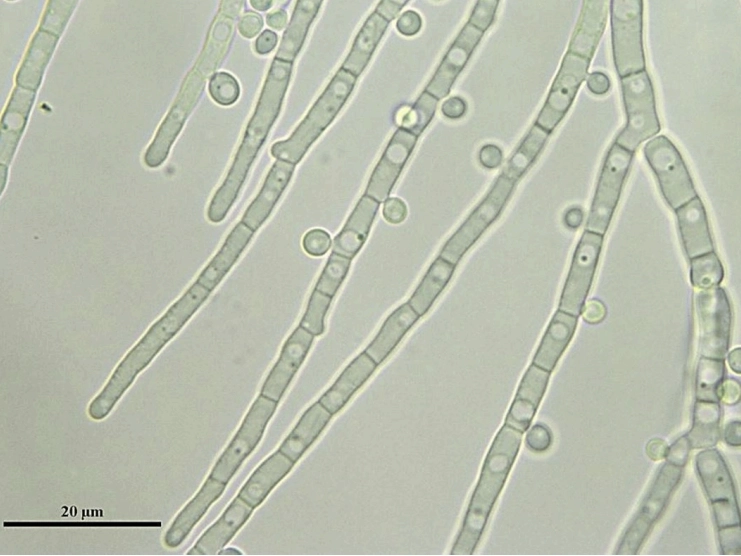Taxonomy
Description
Blastobotrys malaysiensis belongs to a category of species that are referred to within yeast biotechnology as non-conventional yeasts (Mukherjee et al., 2017). Here, non-conventional implies that they might have other phenotypes compared to the industrial workhorse Saccharomyces cerevisiae, such as improved tolerance to process conditions, or different metabolic activities. Yeasts from the Blastobotrys genus are of interest for biotechnological applications due their oleaginous (lipid-accumulating) nature and their broad substrate range (Sanya et al., 2021). By genomic analysis of 332 Ascomycete genomes, B. illinoisensis NRRL YB-1343 (also known as CBS 10337), B. malaysiensis, and four other species were discovered to have xylanolytic activity (Ravn et al., 2021).
The genome assembly and annotation of protein-coding genes of Blastobotrys illinoisensis NRRL YB-1343 was generated by the Geijer research group at Chalmers University of Technology.
How to cite
There is currently no publication associated with the data; in the meantime, please cite the genome assembly using accession number GCA_965113335.1. If you use the annotation of protein-coding genes, please cite:
Ravn, J.; Sörensen Ristinmaa, A.; Mazurkewich, ScotS.t; Borges Dias, G.; Larsbrink, J.; Geijer, C. (2025). Gene annotation of Blastobotrys mokoenaii, Blastobotrys illinoisensis, and Blastobotrys malaysiensis. Chalmers University of Technology. Dataset. https://doi.org/10.17044/scilifelab.28606814.v1If you have used the pages for this species in the Genome Portal, please refer to it in-text as: “The Blastobotrys illinoisensis entry in the Swedish Reference Genome Portal (Retrieved ).” and use the following for the bibliography:
Swedish Reference Genome Portal (Retrieved ), SciLifeLab Data Centre, version 1.5.3 from https://genomes.scilifelab.se, RRID:SCR_026008References
Mukherjee, V., Radecka, D., Aerts, G., Verstrepen, K. J., Lievens, B., & Thevelein, J. M. (2017). Phenotypic landscape of non-conventional yeast species for different stress tolerance traits desirable in bioethanol fermentation. Biotechnology for Biofuels, 10(1), 216. https://doi.org/10.1186/s13068-017-0899-5
Ravn, J. L., Engqvist, M. K. M., Larsbrink, J., & Geijer, C. (2021). CAZyme prediction in ascomycetous yeast genomes guides discovery of novel xylanolytic species with diverse capacities for hemicellulose hydrolysis. Biotechnology for Biofuels, 14(1), 150. https://doi.org/10.1186/s13068-021-01995-x
Ravn, J.; Sörensen Ristinmaa, A.; Mazurkewich, ScotS.t; Borges Dias, G.; Larsbrink, J.; Geijer, C. (2025). Gene annotation of Blastobotrys mokoenaii, Blastobotrys illinoisensis, and Blastobotrys malaysiensis. Chalmers University of Technology. Dataset. https://doi.org/10.17044/scilifelab.28606814.v1
Sanya, D. R. A., Onésime, D., Passoth, V., Maiti, M. K., Chattopadhyay, A., & Khot, M. B. (2021). Yeasts of the Blastobotrys genus are promising platform for lipid-based fuels and oleochemicals production. Applied Microbiology and Biotechnology, 105(12), 4879–4897. https://doi.org/10.1007/s00253-021-11354-3
Son, J. Y., & Kim, M. K. (2022). Blastobotrys illinoisensis, an Unrecorded Anamorphic Yeast Strain Isolated from the Gut of the Earthworm Eisenia fetida. The Korean Journal of Mycology, 50(4), 373–381. https://doi.org/10.4489/KJM.20220041
Changelog
- 10/06/2025 - Update track name from Protein-coding genes to Genes to reflect that the annotation also contains ncRNA genes
- 05/05/2025 - Species first published on the Portal
Page last updated: 05/05/2025

